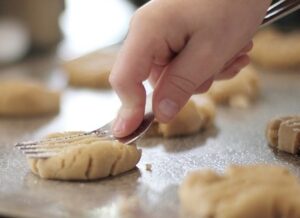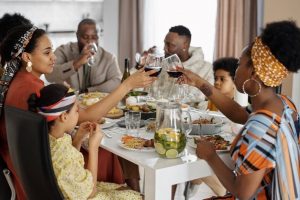 Food memories are more than the taste, smell, color, and texture of food. They can be some of the strongest associative memories we have. This is in part because they involve so many of our senses, as well as our emotions. Your food memories are often a combination of the time, place, people, and emotions of what you experienced while preparing and eating food.
Food memories are more than the taste, smell, color, and texture of food. They can be some of the strongest associative memories we have. This is in part because they involve so many of our senses, as well as our emotions. Your food memories are often a combination of the time, place, people, and emotions of what you experienced while preparing and eating food.
Use the experience of making food with children an opportunity to share your food memories with them. Cooking together can also be a great chance to teach children about family food history and culture. While having lots of tasty fun, children will be learning basic cooking skills, such as food safety, math, science and reading. Young cooks will be practicing eye hand coordination, so expect a few spills. When children can put a dish on the table that they helped make, they experience confidence, self-esteem, and pride.
Tips for success when cooking with children:
- Remember to practice good food safety skills like washing hands and surfaces, both before and after handling food. Do not eat or taste raw dough. Both raw flour and raw eggs often have bacteria that can cause a food borne illness.
- Have realistic expectations of what children of different ages can do in the kitchen and practice patience. If it is not fun, stop and do something else. Try again another day or with a different recipe.
- Have all the ingredients and equipment out on the counter. For very young cooks, you might want to pre-measure some of the ingredients, so all they need to do is dump, pour, stir, and bake.
- When making something like cookies with very young cooks, you might want to prepare the dough ahead of time and have children simply slice or shape a dough. Decorating with sprinkles is definitely something they will want to do, so make sure you have a broom and dustpan handy.
Components of creating fun and positive food memories:
- Decide together -What will you make? Make this a mutual decision. Having a say in the decision is a powerful motivation for children to participate in an activity.
- Buy food together – More conversations, choices and decision-making opportunities abound during this activity. Attempt to accomplish this activity when the family is fed and well-rested.
- Cook together – Cooking is a great way for children to practice counting, measuring, dividing, multiplying, reading directions, and observing science. As they watch solids melt, liquids bake into solids, or watch baking soda and buttermilk react to leaven a biscuit, they just witnessed science in its yummiest form.
- Talk together – Explain what, how and why you are doing something. Share your memories of cooking with family or friends when you were their age. Listen to their ideas and stories
 about cooking. Talk about family traditions.
about cooking. Talk about family traditions. - Eat together – Share your thoughts on what you are tasting. Is it sweet, sour, bitter, salty, etc.? Discuss how you could improve the recipe for next time. Ask children what memory they will have of this cooking experience. Ask if they want to start a new family food tradition.
- Clean up together – Every cook knows that clean-up is part of the experience, so encourage children to share in the responsibility for this task. But who said it had to be difficult or boring? Make it fun!
Colorado State University Extension has recipes and tips developed for cooking up successful dishes at the higher elevations of Colorado kitchens.


Great article for everyone to read! Thanks for writing this and posting